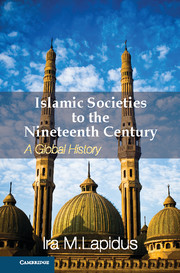Book contents
- Frontmatter
- Contents
- List of Illustrations
- List of Figures
- List of Maps
- List of Tables
- Preface
- Acknowledgments
- Acknowledgments to the first edition of A History of Islamic Societies
- Acknowledgments to the second edition of A History of Islamic Societies
- Publisher's Preface
- Introduction to Islamic Societies
- Part I The Beginnings of Islamic Civilizations
- Part II From Islamic Community to Islamic Society
- Part III The Global Expansion of Islam from the Seventh to the Nineteenth Centuries
- Chapter 25 Introduction: Islamic Institutions
- The Western Islamic Societies
- Islam in Asia
- Chapter 30 Introduction: Empires and Societies
- Chapter 31 The Turkish Migrations and the Ottoman Empire
- Chapter 32 The Postclassical Ottoman Empire: Decentralization, Commercialization, and Incorporation
- Chapter 33 The Arab Provinces Under Ottoman Rule
- Chapter 34 The Safavid Empire
- Chapter 35 The Indian Subcontinent: The Delhi Sultanates and the Mughal Empire
- Chapter 36 Islamic Empires Compared
- Chapter 37 Inner Asia From the Mongol Conquests to the Nineteenth Century
- Chapter 38 Islamic Societies in Southeast Asia
- Islam in Africa
- Conclusion
- Glossary
- Bibliography
- Annotated Bibliography from A History of Islamic Societies, 2nd Edition
- Index
Chapter 33 - The Arab Provinces Under Ottoman Rule
Published online by Cambridge University Press: 05 February 2013
- Frontmatter
- Contents
- List of Illustrations
- List of Figures
- List of Maps
- List of Tables
- Preface
- Acknowledgments
- Acknowledgments to the first edition of A History of Islamic Societies
- Acknowledgments to the second edition of A History of Islamic Societies
- Publisher's Preface
- Introduction to Islamic Societies
- Part I The Beginnings of Islamic Civilizations
- Part II From Islamic Community to Islamic Society
- Part III The Global Expansion of Islam from the Seventh to the Nineteenth Centuries
- Chapter 25 Introduction: Islamic Institutions
- The Western Islamic Societies
- Islam in Asia
- Chapter 30 Introduction: Empires and Societies
- Chapter 31 The Turkish Migrations and the Ottoman Empire
- Chapter 32 The Postclassical Ottoman Empire: Decentralization, Commercialization, and Incorporation
- Chapter 33 The Arab Provinces Under Ottoman Rule
- Chapter 34 The Safavid Empire
- Chapter 35 The Indian Subcontinent: The Delhi Sultanates and the Mughal Empire
- Chapter 36 Islamic Empires Compared
- Chapter 37 Inner Asia From the Mongol Conquests to the Nineteenth Century
- Chapter 38 Islamic Societies in Southeast Asia
- Islam in Africa
- Conclusion
- Glossary
- Bibliography
- Annotated Bibliography from A History of Islamic Societies, 2nd Edition
- Index
Summary
Egypt
The Ottoman conquest of Egypt in 1517 perpetuated, with some modifications, the ongoing system of society. The Ottomans garrisoned Egypt with several corps of janissaries and appointed military governors, inspectors, and finance officers to assure the collection of taxes and the remittance of surpluses to Istanbul. The main functions of Ottoman administration were to pacify the country; control the bedouins; protect agriculture, irrigation, and trade; and thus assure the flow of tax revenues. In the course of the first century and a half of Ottoman rule, the irrigation system of Egypt was rebuilt, cultivation increased, and trade restored by reopening the routes between India and Egypt. Egypt was also important to Ottoman control of the Red Sea, Yemen, Nubia, and Abyssinia, and the holy places in Arabia.
In many respects, Egypt remained a separate political society. Beneath the top level of Ottoman administration, the old institutional structure remained intact. The local Mamluk households continued to be militarily important and were assigned taxable estates. Although the Ottomans appointed a chief judge and a chief syndic for the corporation of descendants of the Prophet from Istanbul, the rest of the scholarly establishment was of local origin. The muftis of the law schools, the chiefs of the holy lineages, and the rector of al-Azhar were the principal leaders of the religious establishment. They were responsible for disciplining their followers and managing the trust revenues and, in the eighteenth century, the tax farms assigned for their personal upkeep, as well as being responsible for the maintenance of the religious function of their schools and fraternities.
- Type
- Chapter
- Information
- Islamic Societies to the Nineteenth CenturyA Global History, pp. 482 - 489Publisher: Cambridge University PressPrint publication year: 2012



